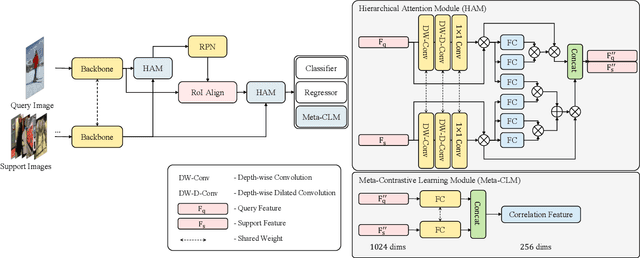Jong-Min Lee
Hierarchical Attention Network for Few-Shot Object Detection via Meta-Contrastive Learning
Aug 16, 2022



Abstract:Few-shot object detection (FSOD) aims to classify and detect few images of novel categories. Existing meta-learning methods insufficiently exploit features between support and query images owing to structural limitations. We propose a hierarchical attention network with sequentially large receptive fields to fully exploit the query and support images. In addition, meta-learning does not distinguish the categories well because it determines whether the support and query images match. In other words, metric-based learning for classification is ineffective because it does not work directly. Thus, we propose a contrastive learning method called meta-contrastive learning, which directly helps achieve the purpose of the meta-learning strategy. Finally, we establish a new state-of-the-art network, by realizing significant margins. Our method brings 2.3, 1.0, 1.3, 3.4 and 2.4% AP improvements for 1-30 shots object detection on COCO dataset. Our code is available at: https://github.com/infinity7428/hANMCL
Boosting Graph Neural Networks by Injecting Pooling in Message Passing
Feb 08, 2022Abstract:There has been tremendous success in the field of graph neural networks (GNNs) as a result of the development of the message-passing (MP) layer, which updates the representation of a node by combining it with its neighbors to address variable-size and unordered graphs. Despite the fruitful progress of MP GNNs, their performance can suffer from over-smoothing, when node representations become too similar and even indistinguishable from one another. Furthermore, it has been reported that intrinsic graph structures are smoothed out as the GNN layer increases. Inspired by the edge-preserving bilateral filters used in image processing, we propose a new, adaptable, and powerful MP framework to prevent over-smoothing. Our bilateral-MP estimates a pairwise modular gradient by utilizing the class information of nodes, and further preserves the global graph structure by using the gradient when the aggregating function is applied. Our proposed scheme can be generalized to all ordinary MP GNNs. Experiments on five medium-size benchmark datasets using four state-of-the-art MP GNNs indicate that the bilateral-MP improves performance by alleviating over-smoothing. By inspecting quantitative measurements, we additionally validate the effectiveness of the proposed mechanism in preventing the over-smoothing issue.
 Add to Chrome
Add to Chrome Add to Firefox
Add to Firefox Add to Edge
Add to Edge